“Changing Styles in Contemporary Quilt Art: Pattern in Motion” by Sandra Sider
March 28, 2018
This article features four contemporary artists working in the quilt medium for more than thirty years: Pauline Burbidge, Michael James, Katie Pasquini Masopust, and Joan Schulze. They all have international reputations not only as artists, but also as influential teachers, lecturers, and authors of books relating to contemporary quilt art. Continuing to produce textile-based artwork throughout their careers, they have transformed their art so radically that their recent pieces hardly relate in any stylistic way to their own earlier quilts. Nevertheless, patterned shape and line remain a constant.
During the 1980s, artists such as Pauline Burbidge had begun to create original blocks with unique patterning that resulted in exciting compositions. When Burbidge, a British artist, began making quilts, she was “wedded to the straight-edged geometric form, and pieced all of my designed blocks. However, there came a time when I needed to free my imagery up, so I began collaging, rather than piecing. Today I work in a very spontaneous way, allowing the images to develop directly with the cloth, without much planning.” Burbidge has always been driven by her subject matter, often expressed in patterned shapes: “water reflections, plant forms, grasses or hedgerows, for example. I like to explore one theme for quite a while, and then there becomes a point when I need to explore new things, although they could be related to the current theme.” Photograms printed via cyanotype have energized Burbidge’s recent quilts, allowing her to reproduce multiple images from nature, using the plants themselves.
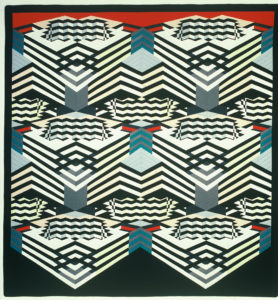
Pauline Burbidge Mirrored Steps 1983, cotton, machine-quilted, hand-finished, 83” x 79”. Collection of Shipley Art Gallery, Tyne & Wear Museums, UK. Photo: John Coles
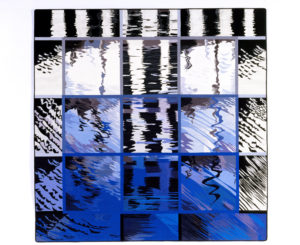
Pauline Burbidge Dancing Lines 1998, cotton, collaged, stitched, quilted, 80” x 80”. Collection of the National Museums of Scotland, Edinburgh, UK. Photo: Keith Tidball.
Michael James, trained as a painter, began his studio quilt career with superbly formalist compositions, eventually associating his pieced designs with private themes, such as music. Describing his 21st-century art, James explains, “One of the things that has been an underlying current in all of my work for the last fifteen or more years really has been this idea of these emotional and psychological undercurrents of all of our lives—how do you represent that or how do you depict that?” Digital printing on fabric has been instrumental in James’s relatively new direction, in which he plays one section of a quilt against another, offering the viewer an intellectual puzzle in the context of evocative imagery. Earlier in his career, James relied on geometric pattern in bands of color to build his surfaces. Today, the vibrant patterns in quilted lines enrich his art and complement the imagery.
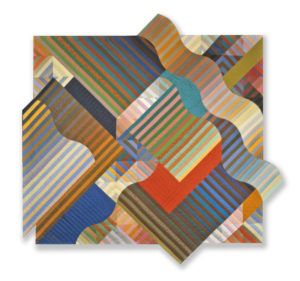
Michael James Red Zinger 1986, cotton, silk,machine-pieced, machine and hand quilted, 67” x 69”. Private collection. Photo: David Caras.
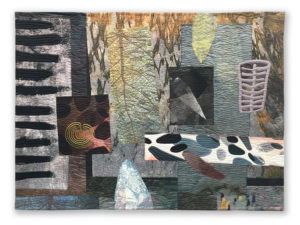
Michael James Allegory 2016, cotton, sateen, dye, pieced, appliquéd, digitally-developed, printed fabrics, 36” x 48.5”.
Also trained as a painter, Katie Pasquini Masopust has come full circle, recently interpreting her own paintings via the quilt medium. She developed her personal style “by exploring what excites me about design and color and trying different things. I have changed my style every few years as I explore one idea to its conclusion for me. Then I come up with another design technique and work on that…. Now I am creating abstract designs based on my paintings.” While this artist has always had a penchant toward abstraction, almost all her quilts contain patterned fabrics through which repetitive detail creates dynamic visual movement.
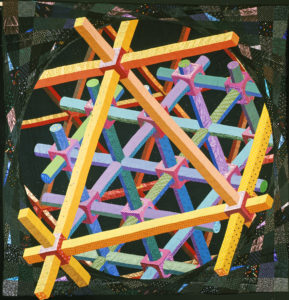
Katie Pasquini Masopust Dimensional Portal 1994, cotton, blends, lamé, satin, machine-pieced, hand-appliquéd, quilted, 83” x 83”. Collection of the International Quilt Study Center & Museum. Photo: Peter Stazione.
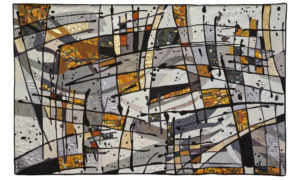
Katie Pasquini Masopust Pizzicato 2011, cotton, blends, lamé, ultrasuede, painted canvas, machine-appliquéd, quilted, 46” x 72”. Private collection. Photo: Carolyn Wright.
For Joan Schulze, “Making things led to making art. I always used what I had available. The family scrap bag was the source of material to make presents. In high school I started making my clothes…. Art, thrift, and fabric stores were my go-to places for unusual art-making materials. When I began my art career, it was natural that fabric would be my material. Over time I included paper and plastic as ‘fabric’ and have incorporated traditional art materials.” The operative word in Schulze’s artistry is “scraps” interpreted as fragments of reality in her collaged quilts, and often structured as strips of multiple images that pattern the surface, just as she used geometric strips in her early quilts.
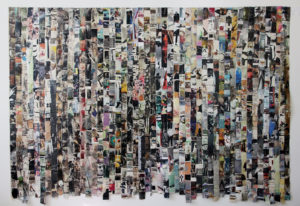
Joan Schulze Opus 2017, packing tape, paper, canvas, tape strip collaged, glued, stitched, mounted on canvas, 94” x 134”.
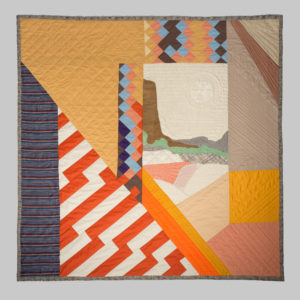
Joan Schulze Where Dreams are Born 1976, cotton, transparent overlays, velour, lace, commercial fabrics. machine-pieced, hand-quilted,90” x 90”. Collection of the San Jose Museum of Quilts & Textiles.
– Sandra Sider is editor of SAQA’s new book Art Quilts Unfolding: 50 Years of Innovation (Schiffer Publishing, forthcoming 2018), the source of all quoted comments from the artists in this article. She is also editor of Art Quilt Quarterly and Curator of the Texas Quilt Museum. A past president of SAQA, Sider has been a studio quilt artist since the late 1970s.



Related Blog Articles
Creative Process
“Fringe: On the Edge of Fiber” — Out Now!
Creative Process
Friday Fibers Roundup: Craft & Color
Creative Process
“Standing Tall: A Heart-FELT Reflection” by Martien van Zuilen